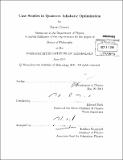| dc.contributor.advisor | Edward Farhi. | en_US |
| dc.contributor.author | Gosset, David (David Nicholas) | en_US |
| dc.contributor.other | Massachusetts Institute of Technology. Dept. of Physics. | en_US |
| dc.date.accessioned | 2012-01-30T16:56:26Z | |
| dc.date.available | 2012-01-30T16:56:26Z | |
| dc.date.copyright | 2011 | en_US |
| dc.date.issued | 2011 | en_US |
| dc.identifier.uri | http://hdl.handle.net/1721.1/68872 | |
| dc.description | Thesis (Ph. D.)--Massachusetts Institute of Technology, Dept. of Physics, 2011. | en_US |
| dc.description | Cataloged from PDF version of thesis. | en_US |
| dc.description | Includes bibliographical references (p. 139-143). | en_US |
| dc.description.abstract | Quantum adiabatic optimization is a quantum algorithm for solving classical optimization problems (E. Farhi, J. Goldstone, S. Gutmann, and M. Sipser. Quantum computation by adiabatic evolution, 2000. arXiv:quant-ph/0001106). The solution to an optimization problem is encoded in the ground state of a "problem Hamiltonian" Hp which acts on the Hilbert space of n spin 1/2 particles and is diagonal in the Pauli z basis. To produce this ground state, one first initializes the quantum system in the ground state of a different Hamiltonian and then adiabatically changes the Hamiltonian into Hp. Farhi et al suggest the interpolating Hamiltonian [mathematical formula] ... where the parameter s is slowly changed as a function of time between 0 and 1. The running time of this algorithm is related to the minimum spectral gap of H(s) for s E (0, 11. We study such transverse field spin Hamiltonians using both analytic and numerical techniques. Our approach is example-based, that is, we study some specific choices for the problem Hamiltonian Hp which illustrate the breadth of phenomena which can occur. We present I A random ensemble of 3SAT instances which this algorithm does not solve efficiently. For these instances H(s) has a small eigenvalue gap at a value s* which approaches 1 as n - oc. II Theorems concerning the interpolating Hamiltonian when Hp is "scrambled" by conjugating with a random permutation matrix. III Results pertaining to phase transitions that occur as a function of the transverse field. IV A new quantum monte carlo method which can be used to compute ground state properties of such quantum systems. We discuss the implications of our results for the performance of quantum adiabatic optimization algorithms. | en_US |
| dc.description.statementofresponsibility | by David Gosset. | en_US |
| dc.format.extent | 143 p. | en_US |
| dc.language.iso | eng | en_US |
| dc.publisher | Massachusetts Institute of Technology | en_US |
| dc.rights | M.I.T. theses are protected by
copyright. They may be viewed from this source for any purpose, but
reproduction or distribution in any format is prohibited without written
permission. See provided URL for inquiries about permission. | en_US |
| dc.rights.uri | http://dspace.mit.edu/handle/1721.1/7582 | en_US |
| dc.subject | Physics. | en_US |
| dc.title | Case studies in quantum adiabatic optimization | en_US |
| dc.type | Thesis | en_US |
| dc.description.degree | Ph.D. | en_US |
| dc.contributor.department | Massachusetts Institute of Technology. Department of Physics | |
| dc.identifier.oclc | 773278401 | en_US |
